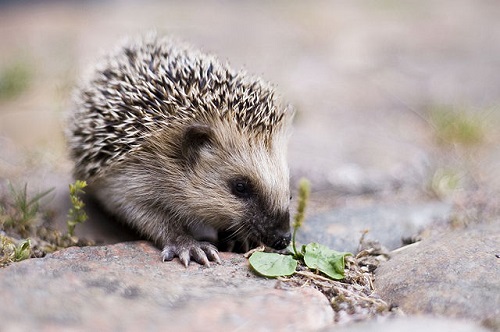Difference Between Hedgehog and Porcupine
The resemblance of hedgehogs and porcupines in that they both have spiny quills have raised the question of what is the difference in these two mammals.We will discuss the each one separately and then conclude the differences.
Hedgehogs
The domain of the hedgehog is predominately Europe, Africa, and Asia with a limited introduction into New Zealand! Different sources have the hedgehog with at least 15 to 17 different species. The quills are made from a substance that is the same as human hair or fingernails. That is keratin, so the quills are extremely stiff hair or nails.i
The reason for their name is that these mammals tend to root through thick bushes, hedges, or heavy undergrowth.ii Because it tends to grunt as itis boroughthrough the forest growth, it was tagged as a hog. However, there is nothing about it that is related to pigs or hogs.
Their diet is small insects and smaller animals such as mice, snakes or even frogs. They will only hibernate if they happen to be in the colder climates, so they tend to be active creatures all year round.
Except for mating season, the hedgehog lives a solitary life. The males may attempt to eat the young hedgehogs while the females are nursing the newborns. The female hedgehog will normally not eat their young, with some rare exceptions. Instead, she will move a disturbed nesting area to a new location. This is interesting as most hedgehogs maintain a lifestyle within about 120-yard radius.iii Somewhat narrows the options.
With the exception of their face, most of the rest of their body is covered with these stiff quills. This includes their back, underside, and sides. With one exception known as the four-toedhedgehogs, these animals have five toes on their very strong back legs. They can easily dig with their curved claws. Their sense of hearing and smelling is excellent, enhanced by large ears and a long snout area, relative to the rest of their body size.
A typical hedgehog will have about 6000 quills on its body. Not quite the delicacy that most predators will enjoy. However, they are still hunted by large predator birds that seem to have gotten around the prickly hair problem. Foxes and dogs have been known to also consider them prey.
Porcupines
To begin with, porcupines are considered to be rodents, with spikes. The Latin name for them means “quill pigs”. There are approximately two dozen variations, with two types: Old World, living in southern Europe, Asia, and Africa. The New World is in North America and the northern part of South America and is aboriginal. They are considered the third largest rodent in the world.iv
The hair on a porcupine is actually soft, with quills thrown in the mix, about 30,000 of them. The quills are very loosely attached to the porcupine’s body with little barbs on the end of them. Quills are basically very stiff hair, and due to the barbed ends and loose connection, easily become part of the predator’s body, mostly around the face. It is a great defense mechanism.
The quills tend to lay flat unless the porcupine is in a defensive position. To combat mythical folklore, porcupines cannot throw their quills, as it was originally thought to be true. The quills come with a topical antibiotic. This really was meant to help in case of self-puncture. So due to the porcupine’s self-preservation predators have the benefit that these prickly little spines will not be fatal, just annoying.
Porcupines are mostly herbivores. Their diet is tree bark, tree stems or just about anything “wood”. The Old World porcupines are not good tree climbers and mostly live on the ground, and tend to be adept at swimming. The New World porcupines can live in the trees. The chances of seeing one during the day are minimal, as they are nocturnal.
Summary of Differences
Scientifically these two mammals are considered to be two different species. The only similarity is the spiny hair or quills. Hedgehogs can grow up to 12 inches and weigh less than 2.5 pounds. A porcupine can grow as much as 36 inches and weigh in close to 35 pounds.
When defending themselves, hedgehogs curl up into a ball, protecting their feet and hands. In addition, none of their quills are easily detached. Porcupines do not curl up into a ball. They will simply allow the easily detached quills to become part of the predators, then waddle away and grow a new set of quills. v So a hedgehog will sort of plead “please do not eat me by curling into a ball” while the porcupine will say “Oh, you want to eat me, well chew on this for a while” then walk away.
We trust you enjoyed this comparison of the hedgehog and porcupine. Now you know, they are not the same.
- What is the Difference between Executor and Trustee? - December 18, 2016
- The Difference Between Negligence and Gross Negligence - November 23, 2016
- The Difference Between God and Jesus Christ - November 7, 2016
Search DifferenceBetween.net :
Leave a Response
References :
[0]http://animals.sandiegozoo.org/animals/hedgehog
[1]www.animals.nationalgeographic.com/animals/mammals/hedgehogs/
[2]http://www.awf.org/wildlife-conservation/hedgehog?gclid=Cj0KEQjwi_W9BRD_3uio_Jz-p8UBEiQANU80vqul0S6-FEfG_K1FU8_G7TzSUbRnlToPyTMeBLEU9lQaAuKz8P8HAQ
[3]http://animals.mom.me/difference-porcupines-hedgehogs-2388.html
[4]https://en.wikipedia.org/wiki/Hedgehog

